Abstract
The first author, Elisa Gabrielli, has been a distance runner for many years, and then at a particular point in her career, she decided to move over to the 3000-m steeplechase. She was attracted by this discipline as she believed that it would be the appropriate discipline for her, due to the challenge it provided her, and the necessary knowledge and awareness she had through her studies. For reasons that are discussed in this report, the 3000-m steeplechase is a race that is more difficult to interpret and manage biomechanically and physiologically than most others. Combining this with her PhD allowed her to use a multidisciplinary approach to review the competitive experience gained in this discipline. During this period, she indeed not only deepened the technical aspects of her training, but also those that underlie this discipline, through her knowledge of sport, with particular reference to the female athlete. Through her technical research, she was able to take ‘snapshots’ of what could happen from the physiological point of view. With satisfaction, she improved her performance in the 3000-m race and in the 3000-m steeplechase. How? In particular, she worked on her running technique through specific exercises. She worked on de-contraction and posture, while saving energy consumption. She worked on the control of her breathing, and she took into account her prevailing heart rate. This was all in combination with the consumption of specific nutrients, as she tried to manage the production of lactate with the training of the red muscle fibres that are rich in mitochondria. Finally, she tried to improve her perception of strenuous work, by training at high altitude. This allowed her not only to improve her physical performance, but especially to improve her mind-set, which allowed her to be more confident in herself and her abilities.
Key words: 3000-m steeplechase, rating of perceived exertion, aerobic and anaerobic performance, heart rate.
The 3000-m steeplechase is included in the general category of ‘middle-distance running’.1 However, it really should be considered as a discipline with particular characteristics, as well as a race full of charm, and in some ways, still mysterious. In addition to the uncertainty inherent in every race that is run, there is the added distinctive element of the barriers and the water jump, and thus there is the need to overcome these barriers. All of this makes the outcome very uncertain, until the end of each competition.
The standard steeplechase (which is considered here to be 3000 m, if not stated otherwise) as a discipline has been introduced recently for women. This race has been classified as a commitment to an ‘intermediate’ distance, between short and fast races, and long-distance running. It also represents a ‘junction’ between a flat race and a middle-distance race with obstacles, as the just over seven laps of the track include the need to overcome 28 fixed barriers, plus facing the water jump seven times. The latter comprises a barrier followed by a hole filled with water that has an oblique, up-sloping, bottom.
The racing action between these obstacles must have the classic characteristics of fluidity, de-contraction, and economy. The overcoming of the obstacles, which are fixed on the track, is similar to the action of jumping over a hurdle, with classical action that does not slow the leading leg down. In the passage through the water jump, the athletes rest their leading foot on the top of the barrier, and use the other leg to provide an effective boost, to land almost at the end of the water pit.
This race covers a distance that requires technical efficiency, muscle energy, personality, and psychological security to enforce the between-barrier rhythm, and the appropriate acceleration and deceleration to surmount the obstacles. Analysis of energy expenditure indicates the use of aerobic mechanisms almost all of the time, while the duration of the race allows a certain amount of blood lactate to be disposed of by the body during the race.
With the standard 3000-m race, it has been shown that at the start, the plan is to run at a speed that is higher than that of the aerobic threshold, and so this will, of course, also apply to the steeplechase. Thus, as the aerobic mechanisms are maximally exploited, this means that the additional input of energy must be derived from the anaerobic lactic energy mechanism. An increase in energy demand (even where this is apparently not high) can result in a significant increase in the intervention of this anaerobic mechanism. During the steeplechase, immediately before the obstacles and in correspondence to their being surmounted, the muscles will produce peaks of lactic acid. During the approach, instead, the production of lactate is more reduced, and there is a trend in its action that is known as 'pulsatory'.
During the race, the biomechanical changes required for this extra muscular effort will occur 35 times: as many times as the number of barriers and water jumps that need to be overcome. The steeplechase athlete must be able to withstand these biomechanical alternations with variable production of lactate from the muscles. Therefore, in addition to having excellent muscular performance, the best steeplechase athletes must also have the following:
Good technique, to surmount the obstacles (from this point of view, the control of both the left and right parts of the body with the same efficiency is obviously a big advantage). This ability to overcome the obstacles, however, must be referred to the speed at which the steeplechase is run. The athlete must have the ability to ‘adjust’ to the right step, to get closer to the correct distance as the barriers are approached. This implies that during training, specific practice with the barriers has to be carried out, as will be needed during the competition. Another advantage is the ability to easily change (and with the lowest energy expenditure) the parameters of the inter-barrier run. This includes the length and frequency of the stride, and the boost to the stride, again to get closer to the correct distance in the approach to the barriers.
The know-how to tolerate the constant changes in the muscle work, which requires discipline.
To be able to repeatedly express good levels of muscle force (as required to surmount the barriers and the water jump), even in the presence of high levels of lactic acid in the muscles. To this end, it might be useful to use the type of training known as ‘intermittent training’.2
In steeplechase competitions, tall and lanky athletes have some advantages. These anthropometric features allow significant saving of energy when the obstacles need to be overcome, as they allow good positioning of the centre of gravity of the body with respect to the barrier, which is known to provide more economical movement than when the centre of gravity of the athlete needs to be raised a little more than usual.
However, tall and lanky athletes also have some disadvantages, such as those linked to their less rapid movements of the limbs when passing over the obstacles, due to their longer lever and the more demanding movements needed. There have been, and there are still, athletes of medium and short stature who have achieved excellent results in the steeplechase. Another particular quality of the steeplechase athlete is the ability to express speed strength; i.e., dynamic force and damping force.3 The muscles of the lower limbs need to be able to absorb the kinetic energy from the moving body, to store it in the form of elastic energy during the impact with the earth after the obstacle, and to give it back during the next jump.4 The anthropometric characteristics of the successful steeplechase athlete are therefore similar to those of the distance runner: lean, with long and slender, but light, musculature.
The steeplechase athlete must also have the outstanding qualities of a hurdler, which means the ability to minimise the disturbance due to the barriers during the race. Therefore, this discipline also needs the characteristics of neuromuscular coordination, fluency and joint mobility, smooth movement, and good timing.
The women's 3000-m steeplechase was run for the first time at the Beijing Olympics in 2008. Currently, the world record is held by the Russian Gulnara Samitova, with a time of 8:58.81, as the first ‘under-9-minute’ women’s steeplechase in history; however, as a new event, the times and the records are sure to improve very quickly. The first competition for the female 3000-m steeplechase that was a valid part of the World Championships was on 8 August, 2005, in Helsinki. It was thus a century before women could officially have access to this athletics specialty! For several years, in Eastern Europe and the Soviet Union, female athletes had indeed been training for this type of competition (previously the women’s steeplechase was 2000 m), and if we look at the list of the best performances (including the records), we have indirect evidence: many athletes belonged to these nations.
The different physiologies of the sexes, and the different expectations of family and society, have usually been against these female athletes, compared to the males, as these are aspects that affect the practice and success of women in sport to a great extent. However, in many sports, and particularly in some of the relatively new sports that are practiced by women, there are still good opportunities available, as these athletes have yet to reach the limits beyond which any improvement is increasingly difficult to achieve, as is seen for the majority of male athletics competitions. So currently, women have better margins for improvement than those for men.
The modern conception of the steeplechase sees this sport not only as a middle-distance specialty, where the concept of organic preparation is the key issue, but also as a specialty in its own right, where the technical aspects have importance and the approaches undertaken are not random, but involve choices and the promotion of real readiness from the juvenile phase.
Some years ago, in high-level competitions, there were differences of 40 s to 50 s in the times of the standard 3000-m race and the steeplechase for the same athlete.
Improved success over the barriers and the water jump will now be required to reduce this gap. With the surmounting of the obstacles technically perfect today, this involves a loss of no more than 5-6 tenths of a second for the barriers, and no greater than 1-2 tenths of a second for the water jump. The ideal that can thus be achieved should be a difference of 20 s, or a little more, between an athlete’s best times for the standard 3000 m and the 3000-m steeplechase. This would allow for an average loss of 0.4 tenths of a second for each barrier (of 28) and of 0.9 tenths of a second for each water jump (of seven).
Given the positive growth in the great practitioners of this discipline and the opportunities for improvements in the methods and the training load during the approach to competitions, this sport has the need for investigations into non-traditional training sessions for these athletes, to lay better foundations for future studies of the loads of the steeplechaser. It has been said that, “the barriers are especially hard for a woman”. This is demonstrated by the low number of athletes who opt for this race. After all, the barriers and the water jump still instil fear in many. The other side of the coin is that if you are a good quality middle-distance runner and you are not worried by these obstacles, you can still have a place in the sun on the international running scene. This is not now the same for middle-distance runners; the minimum qualification times are much more difficult to reach, and competition is very strong.
The secret of the ease with which an athlete can run the steeplechase lies in their familiarity with the track and the barriers, and their affinity with the water jump. In particular, aerobic training based on the Faltrek method could be useful. The Faltrek method comes closest to the physiological, metabolic and technical characteristics needed for preparation for hurdles, by changing the protocol models that are normally used. By programming in the field, we can analyze a high level of experience that can be a practical and real reference for coaches, athletes, and scientists. The objective is to take note of the situation and to be clear on the current condition of the body, monitoring it and taking advantage of the effects and adaptations, thus contributing to the achievement of maximum performance.
The studies for her PhD allowed Elisa Gabrielli to review the competitive experience that she has gained in this discipline with the use of a multidisciplinary approach. Indeed, she has not only deepened her technical aspects and improved her training, but she has also investigated this event through her knowledge of the technical aspects, with particular reference to the female athlete.
Due to the new involvement of females in the 3000-m steeplechase, the training loads and the race results are initially describe for a 3000-m steeplechase female master athlete during her PhD. This particular condition allowed this athlete to achieve specific and personal technical experience directly related to her own 3000-m steepchase performance. One of the difficulties in this sport is a reference test or a field test that is useful for the monitoring of the state of the athlete.
The aim was to compare the training load (TL) based on Fartlek training and the resulting physiological responses by conducting and evaluating various physiological tests. Pre and post Kenya conditions were used to identify a more effective method of TL that would reflect most of the features of the discipline, compared to the TL used normally
Materials and Methods
Subject
In the present study of a national 3000-m steeplechase athlete (age, 37 years) the anthropometric parameters of the athlete were: 48 kg weight, 162 cm height. She was a PhD student in the Laboratory of Functional Evaluation, at the ‘G d'Annunzio’ University of Chieti–Pescara, Italy. She gave her informed consent for the collection of her heart rate and her rating of perceived exertion (RPE) during her training and in her competitions in 2011 and 2012 (at both Italian and international meetings). She also spent a few months in the higher education and research facility at the High Altitude Training Centre, of the University of Champions, Iten, Kenya, in a period from 2011 into 2012. Within the same structure, she spent time on her training load. The procedures were in accordance with ethical standards, and the study conformed to the Declaration of Helsinki.
Fartlek
Fartlek training consists of a ‘speed game’, as 15 repetitions of 1 min of slow work followed by 1 min of fast work, for a total of 30 min of work. During the Fartlek training, she tried to maintain a heart rate near that of her anaerobic threshold, as evaluated by the Mader test. Other possible training included interval training (10 repetitions of 200, 300 and 400 m) and the long run (10-15 km distance).
To monitor the intensity of the training, she used the ‘RPE session’ or ‘Borg C10 value’.5
Instrumental recordings
Heart rate (HR) was measured and recorded using a Garmin Forerunner 110. This instrument catalogued all of the data on a personal sports page of the Garmin website, from where they were downloaded and stored. The RPE rating was recorded according to the Borg CR-10 scale, with which she was previously familiarised. The HR was recorded during all of the training sessions, and the RPE was recorded at the end of them. The RPE was multiplied by the minutes of the respective sessions, to determine the training load (TL). The RPE category scale followed the ratio scale (CR10), which has a range that goes from 0 to 10, with 10 corresponding to the stable concept of “the feeling of the greatest effort that the person had ever perceived in life, but with the possibility to reach a higher value”. The test was administered immediately after training or competitions, or after a shower (about 30 min after).
The Mader test was carried out on a treadmill to determine her anaerobic threshold. The Mader test is a method that was proposed by Mader et al. [1976],6 with the objective of identifying the anaerobic threshold. More precisely, the aim of the Mader test was to define the exercise intensity that corresponds to a concentration of lactic acid in the blood of 4 mM. This value has been defined as the intensity of the anaerobic threshold, although in most cases, the maximum lactate at steady-state (which precisely corresponds to the anaerobic threshold) shows a lower concentration of lactic acid in the blood. However, the intensity at 4 mM is a parameter that is frequently used in specific strength training. In addition to identifying the intensity at a concentration of lactic acid in the blood of 4 mM, the Mader test is important to study the kinetics of lactate increases, to identify the anaerobic threshold and the personal training rates, and to test for changes in terms of the athlete’s form during the year.
The Mader test follows a sub-maximal,6 step by step at constant increasing intensity protocol, which is followed by a pause for recovery. From one step to the next, there is a gradual increase in the work load. At the end of each step, a measurement is made of the concentration of lactic acid in the blood, from a drop of blood from the ear lobe or the finger, which is analyzed using specific equipment. The test duration is approximately 45 min, which also takes into account the recovery stages.
The HR and RPE were collected during all of the training sessions: in Italy, at 0 m a.s.l., and in Kenya, at 2500 m a.s.l.. In particular, the training sessions were conducted in Italy (at 0 m a.s.l.), seven times per week, and at the High Altitude Training Centre, University of Champions, Iten, Kenya, in the period between 25 December, 2011, and 11 January, 2012 (at high altitude: 2500 a.s.l.), 14 times a week. The training sessions in Kenya had the goal of improved metabolic aerobic power at altitude. The work was over 100 km.
Elisa Gabrielli participated in national competitions in athletics, such as the 3000-m indoors, national cross-country runs, and the steeplechase.
Her regular readings are reported in Pubmed Central and also on several Italian and international websites, including:
www.steeplechase.com; www.losportitaliano.it; www.libreriadellosport.com; www.en.wikipedia.org; www.IAAF.org; www.fidal.it.
Results and Discussion
Training load
Table 1 shows the representative mean values for HR, RPE and energy expenditure recorded for Elisa Gabrielli during typical training sessions in Italy and in Kenya.
Table 1.
Heart rate and rate of perceived exertion during training at sea level (Italy) and at high altitude (Kenya).
| Training | Heart rate (bpm) | Rate of perceived | Calories | ||
|---|---|---|---|---|---|
| Minimum | Maximum | Mean | exertion | (kcal) | |
| Italy | 50 | 160 | 130 | 4 | 500 |
| Kenya | 70 | 185 | 150 | 6 | 600 |
Laboratory tests
The results of the Mader tests (July 2011, January 2012) and the calculated threshold analyses are given in Table 2, and are illustrated in Figures 2 and 3.
Table 2.
Results of the Mader tests and calculated thresholds for July 2011 and January 2012 (after the high altitude sessions in Kenya).
| Period | Analysis | Velocity (km/h) |
Lactate (mM) |
Heart rate (bpm) |
|---|---|---|---|---|
| July 2011 | Mader test | 10 | 1.4 | 143 |
| 12 | 1.6 | 157 | ||
| 14 | 3.2 | 174 | ||
| 16 | 7.9 | 185 | ||
| Anaerobic threshold | 14.4 (4 min, 10 s per km) | 4 | 170 | |
| Aerobic threshold | 12.8 (4 min, 41 s per km) | 2 | 160 | |
| January 2012 | Mader test | 10 | 0.8 | 138 |
| 12 | 1.2 | 156 | ||
| 14 | 2.8 | 167 | ||
| 16 | 8.1 | 182 | ||
| Anaerobic threshold | 14.4 (4 min, 10 s per km) | 4 | 170 | |
| Aerobic threshold | 13.3 (4 min, 30 s per km) | 2 | 163 |
Fig 2.
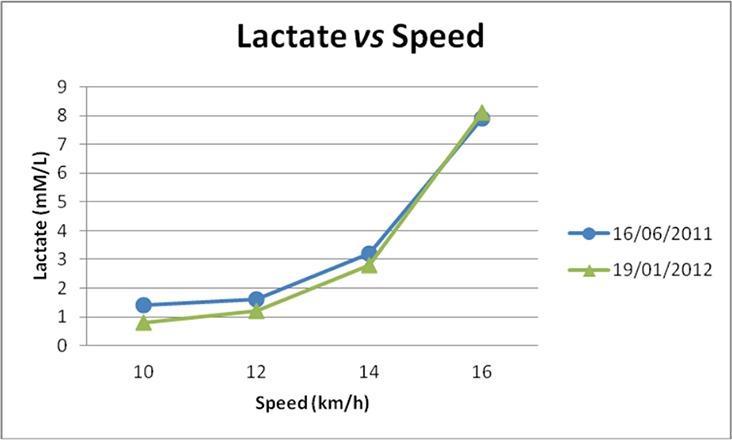
Results of the Mader test, as a comparison of lactate versus the speed obtained in two different periods in Italy at sea level: one in June 2011, and the other in January 2012, after the high altitude sessions in Kenya (data plotted from Table 2).
Fig 3.
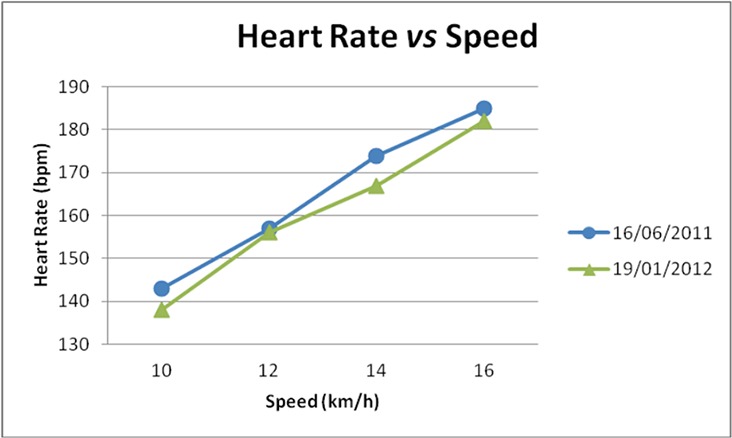
Results of the Mader test, as a comparison of heart rate versus the speed obtained in two different periods in Italy at sea level: one in June 2011, and the other in January 2012, after the high altitude sessions in Kenya (data plotted from Table 2).
Borg values and heart rate
Following the Fartlek training in Italy, Elisa Gabrielli obtained an increase, although minor, in her race results (see Figure 5), probably due to specific biological adaptation. Figure 4 shows that in the early period (before 6 December, 2011), her Borg values decreased along with her increased HR; in the later period, following a peak of her Borg values and HR, her Borg values were similar to those of the first period, while she recorded a lower HR, which indicated the effectiveness of the Fartlek training. Indeed, the more intense training resulted in a lower HR in terms of that of the first period. Similarly, following the Fartlek training in Kenya, seen in the later period, her Borg values were higher while she had a lower HR with respect to the first period.
Fig 5.
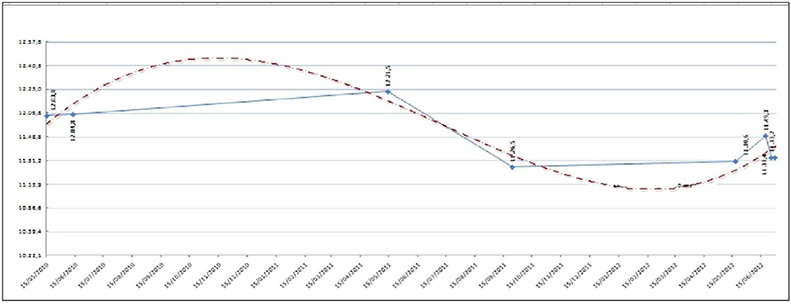
The personal times of the athlete, the first author, Elisa Gabrielli, in Italian competitions from 2010 to 2012, where her improved the performances in the 3000-m steeplechase can be seen. The peaks are characteristic of intense periods of work or adverse climate conditions. Dotted line represents the tendency of the Borg values.
Fig 4.
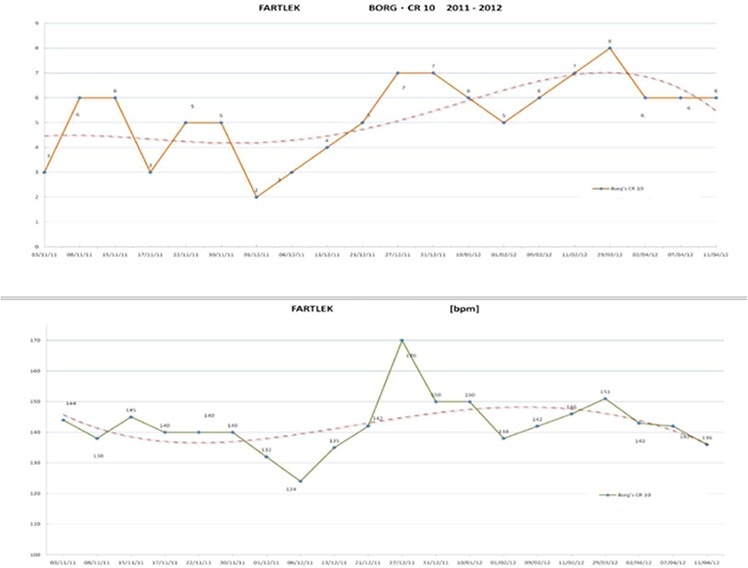
Fartlek training in Italy and Kenya. The early period (before 6 December, 2011) shows that the Borg values decreased according to increased HR; in the later period, following the peak Borg values and HR, the Borg values remained similar to those of the early period, although a lower HR was recorded, indicating the effectiveness of the Fartlek training. Dotted line represents the tendency of the Borg values.
The female 3000-m steeplechase athlete definitely participates in a niche sport in Italy. Given the approach that is needed for young athletes to participate in the steeplechase, these athletes deserve some specific analysis, not only from the physiological point of view, but also in terms of the neurophysiological commitment and trauma. The purpose of this description is to consider the training loads and the race results of a steeplechase female master athlete, Elisa Gabrielli, during her PhD, which focused on the awareness of the importance of the physiological parameters of HR, lactate levels and RPE. This approach helped her to develop her knowledge and ability in her chosen sport, and to put this into practice during training and competitions.
The recent low involvement of females in this sport is linked to the poor data in the literature. The peculiarity of this particular descriptive report is that the athlete can still participate in the activities of her sport while attending her PhD course, during which she was studying her own sport discipline. This particular situation allowed her to achieve specific and personal technical and physiological experience directly from her own steeplechase performance.
Fartlek training is based on rhythm changes, and it appears to be particularly efficient in training for the steeplechase. It is similar to the procedure during the jumping of the barrier, which forces the use of different aerobic power. Fartlek training is thus similar to the steeplechase, with its rhythm changes. Moreover, it is easy to collect data in real time with common tools, and to analyze these data to improve training.
This discipline needs further investigation in terms of the physiological and technical aspects. The Laboratory of Functional Evaluation is a good example of an integrated approach of educational programme and support in training for a willing athlete.
In conclusion, Elisa Gabrielli found the work based on Fartlek training at high altitude and at sea level very useful. In her experience it has shown positive results, which culminated in a general improvement in her cardiac efficiency and her endurance performance, both at sea level and at high altitude. She hopes that this study will stimulate the curiosity for research in a large number of athletes, to be able to obtain data that are statistically more significant. The identification of this pilot study provides a proposal for a protocol of a performance model and a method for evaluation of the technical and metabolic matters related to this race with obstacles. Therefore, this study focuses exclusively on the essence of the method, rather than on a critical discussion of the results of the experimental data
Fig 1.
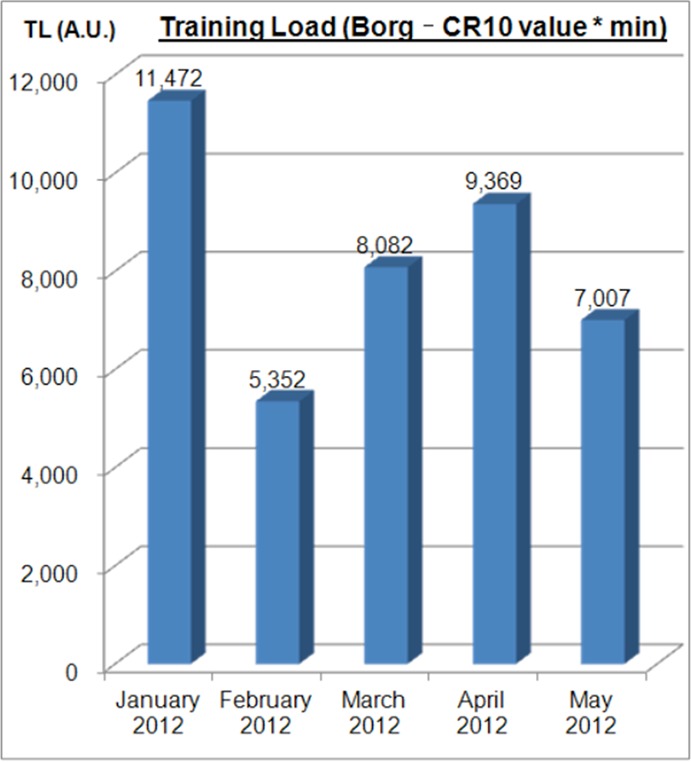
Training load (TL) achieved during the first months of 2012, after the high altitude sessions in Kenya. The training load was calculated from the RPE multiplied by the duration of the training (in min), with the values expressed as arbitrary units (A.U.).
Acknowledgements
EG would like to thank sport friends and the family for supporting her in this sport. This study was supported by the following research grants: PhD course grant in Basic and Applied Medical Science, and co-funding research projects of national interest (COFIN) 2012N8YJC3 to TP.
Contributor Information
Elisa Gabrielli, Email: elisainchains@yahoo.it.
Stefania Fulle, Email: sfulle@unich.it.
Giorgio Fanò-Illic, Email: fano@unich.it.
References
- 1.Kenney WL, Hodgson JL. Variables predictive of performance in elite middle-distance runners. British Journal Sports Medicine 1985; 19:207-9 doi:10.1136/bjism.19.4.207. [DOI] [PMC free article] [PubMed] [Google Scholar]
- 2.Gist NH, Fedewa MV, Dishman RK, Cureton KJ. Sprint interval training effects on aerobic capacity: a systematic review and meta-analysis. Sports Medicine 2014; 44:269-79 doi:10.1007/s40279-013-0115-0. [DOI] [PubMed] [Google Scholar]
- 3.Lebiedowska MK, Wente TM, Dufour M. The influence of foot position on body dynamics. J Biomechanics 2009;42:762-6. doi:10.1016/j.jbiomech.2008.12.021 [DOI] [PMC free article] [PubMed] [Google Scholar]
- 4.Stergiou N., Bates B.T., James S.L. Asynchrony between subtalar and knee joint function during running. Med Sci Sports Exerc 1999;31:1645-55. [DOI] [PubMed] [Google Scholar]
- 5.Dantas JL, Doria C, Rossi H, et al. Determination of blood lactate training zone boundaries with rating of perceived exertion in runners. J Strength Cond Res 2015; 29:315-20. [DOI] [PubMed] [Google Scholar]
- 6.Mader A, Liesen H, Heck H, et al. (1976) Zur Beurteilung der sportartspezifischen Ausdauerleistungsfahigkeit im Labor. Sportarzt Sportmed 27(80-88):109-12. [Google Scholar]


